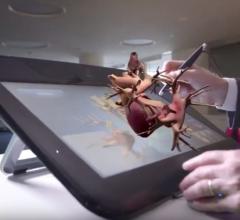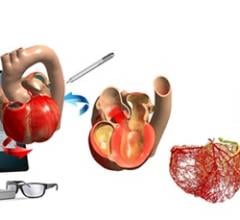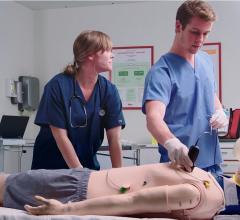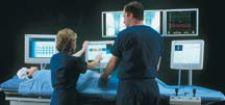
Technicians in The Virtual Care Unit at Riverside Methodist Hospital in Columbus, Ohio, practice imp
What do you think of when you hear the word simulation? Probably the first thing that comes to mind is flight simulation, where pilots and pilots-in-training learn how to fly. Simulation has been used over the years, most recognizably, for flight and combat; however, a new area in which simulation technology has taken hold is medicine.
Medical simulation technologies have evolved from anatomical models to computer-based simulations technology. And, as computers have become more sophisticated with faster processors and increased memory capacity, a new area of simulation has surfaced: New medical simulation technology is so revolutionary that, in some cases, it is designed to resemble a surgical suite. These “simsuites” are increasingly being used to train physicians and medical residents to hone their skills in certain areas of medicine — whether microsurgery or percutaneous revascularization of arteries — and to build confidence, enabling them to practice on real-time simulated cases. As a result they become more proficient in their field of practice.
But certain questions remain: (1.) How does a medical facility, a university and even a hospital network know what type of simulation technologies and tools are appropriate? (2.) What are the healthcare advantages of having an in-house system versus sending medical staff to simulation training centers? (3.) What type of setup is needed to support an in-house system? (4.) Is the expense justifiable? (5.) What's the return on investment?
This article will provide some general guidelines in terms of questions that hospitals and medical facilities should ask when considering the selection of simulation training systems. It will also provide a quick reference guide on major simulation companies vying for hospital and medical facility business in the diagnostic and invasive cardiology field.
What the Players Offer
Today's “sim” systems, which comprise an interface device — the simulated patients and the inducer device, a computer and several monitors — are available with similar components. Depending on the sophistication of the system, the monitors will provide the operator with an array of patient information as well as instructional information during the simulated procedure.
Where sim companies differ from each other is in their software packages, the sophistication of the tools that have been programmed into the system (e.g., the realness or responsiveness of the tools or the tactile feedback following a push or a pull motion when using a simulated guidewire, for instance), and the special features that are offered, such as expandability of the system, monitoring, analysis and reporting.
Four companies offer medical simulation systems that afford physicians and other healthcare professionals simulation-based medical education (SBME): Immersion Corp., Medical Simulation Corp., Mentice Inc. and Simbionix USA Corp. Although all these companies offer simulation systems geared toward medical education, there are differences between what the companies offer — some subtle and some more distinguishable. The common thread between them is that they are providing and developing programs that emphasize patient safety and quality of care. Below is a quick rundown of what each has to offer.
Immersion Corp.
The Immersion Corp. offers simulation systems in a variety of industries, including automotive, gaming and medical, just to name a few. Immersion's simulation technology is geared toward providing its users with a real-world experience, whether it's guiding a user's movements in industrial control simulation or allowing medical professionals to practice difficult cases in a virtual environment, risk-free.
Immersion specializes in providing integrated simulation systems that enhance practical learning. Immersion's medical division (Immersion Medical) is on the forefront of SBME. The company offers simulation training in endoscopy, endovascular, hysteroscopy, lap-
aroscopy and vascular access. The company believes that simulation training not only offers state-of-the-art training opportunities for medical professionals, but also provides financial and societal benefits as well.
Medical Simulation Corp. (MSC)
MSC refers to itself as a “full-service” training and education provider. The company provides SBME for medical products and procedures, which are used to train a broad range of personnel who work in the medical field, from sales representatives to medical professionals, such as doctors and nurses.
MSC's clients range from medical device manufacturers to medical societies and hospitals. The company provides tailored education simulation systems and programs through its SimSuite surgical environments (SimSuite System) that allows medical teams to practice patient care in a risk-free environment. Physicians and their teams can plan, perform and virtually follow a SimSuite case through the entire patient care process.
Mentice Inc.
Mentice provides a complete line of virtual reality (VR) products ranging from endovascular simulators to cardiovascular simulators. The company's goal is to leverage simulation technology to enhance and improve medical education and training. Mentice's first simulator was the Procedicus VA, used for training physicians to perform virtual arthroscopy for shoulder surgery. The company expanded its product portfolio and now offers products and applications such as its Procedicus VIST, a vascular intervention system trainer that is used in the cardiology, electrophysiology and radiology fields. Mentice also offers Procedicus MIST for laparoscopic procedures, and products and applications for arthroscopy knee and shoulder procedures.
Simbionix USA Corp.
Simbionix has a line of computer-assisted medical training simulators. The company's specialty is minimally invasive surgery (MIS) simulation. Its Mentor line of MIS simulators encompass a wide range of MIS procedures, including an upper and lower GI simulator that allows physicians to perform colonoscopies and gastroscopies; the ANGIO Mentor simulates an interventional endovascular procedure environment. Like its competitors, Simbionix has developed technology that mimics internal organ functions, bodily fluid movement and tool-to-organ interaction.
Questions to Ask
When considering a simulation training system (or platform), hospitals, medical centers and societies need to understand what questions to ask the simulation system companies. Simulation platforms can be divided into two main areas: systems and services. The system portion of the simulator platform includes a hardware and software component, as well as any special features, such as hemodynamic and pharmacology monitoring. The service end includes IT expertise, support and upgrades. Hospitals, medical institutions and medical societies should do their homework prior to leasing or purchasing a medical simulation platform or system. Below are some key simulation platform framework questions for facilities to consider when meeting with a simulation company.
Skills and Drills
Amy Shannon, MSC's vice president of marketing,
recommends asking: What are your facility's simulation goals? Having its physicians remain proficient with current procedural techniques and skills, such as performing a laparoscopic procedure or does the hospital want its doctors to develop new skills, such as the placement of a pacer lead? All the sim companies provide systems that allow medical professionals to practice drills to improve procedural skills to a varying degree. The question remains: What are your facility's needs? Invest in a table-top system (more like a computer on a cart) or devote an entire suite to medical simulation (e.g., an MSC SimSuite)? Depending on the applications your facility seeks and how it intends to use the system(s), knowing and understanding the varying degrees, as well as the system training limitations, is important.
Cognitive Approach to Training
Does the simulator company make a cognitive application available as part of the training? This may be important to some facilities in order to monitor their medical staff in terms of how they act and react in certain situations. For example, MSC’s SimSuite provides a “patient care process solution” as part of its SBME program, which gives medical teams and physicians a pre-procedure briefing. It presents the medical team with patient background, a real-time case environment that mimics a real-world case and a post-procedure assessment and follow-up. A cognitive approach to training can assist medical personnel in improving human perception skills and critical thinking, which in turn enhances the learning experience.
Pharmacological Modeling
Does the sim system come equipped with a pharmacological modeling application? Such a feature not only adds presence and sophistication to the simulator, but also enhances the simulation experience by adding an extra touch of reality to the training. Depending on the sophistication of the system, some pharmacological modeling features enable full pharmacological interactivity. For example, if a physician forgets to give an antiplatelet drug during a particular case or gives too much of it, this would set off a chain of events that, within the system for instance, would require the physician to take counteractive measures to correct the situation.
Hemodynamic Modeling
What are the system's hemodynamic monitoring capabilities? As in the real world, you'll want to invest in a system that has good vital signs simulation capabilities, not a system that simply adds vital signs background noise of beeps and blips. A true hemodynamic monitoring simulator should provide a full array of vital signs outputs, such as heart rate, blood pressure and ECG leads. It should also be responsive to the physician's or medical team's actions and influence decision-making.
IT Expertise
If you represent a hospital, medical center or hospital network that's considering establishing an “in-house” simulation training program, below are a few points to consider:
• How complicated is the system to operate?
• What IT expertise will be required?
• What is the simulation system manufacturer offering in
terms of simulation system support?
• Who's going to run it?
For example, MSC offers support behind every SimSuite system. The company tailors simulation systems to customers' specific needs, ensuring the highest utilization rate. Furthermore, MSC provides a full-time employee, at MSC's expense, to oversee the whole application. The MSC employee will service, educate and work with the facility to coordinate and implement simulation training.
Obsolescence
Are upgrades standard? As computers become more powerful, simulation technology will evolve. Is the simulation system static or ever-evolving? How is the system upgradeable? As part of your service contract or agreement, or even as part of your system purchase, find out how often and when the company intends to release software and even, in some cases, hardware upgrades. There's nothing worse than being stuck with “cutting-edge” technology that quickly becomes outdated.
Performance Feedback
All the sim systems discussed offer performance feedback to varying degrees. For instance, Simbionix simulators offer “sophisticated performance evaluation features” that allow instructors to monitor individuals and groups. They say their systems simplify the evaluation between trainee and training progress. MSC and Mentice offer a similar feature for progress monitoring as well as statistical reporting and objectives assessment.
Frequency of Use
How often will the system be used? What will its use(s) be? Who will use it? Answers to these questions will probably give you some idea of what type of system your facility should invest in. For example, what percent of your hospital might benefit from training on the system?
The MSC SimSuite offers an Advanced Cardiac Life Support recertification program that would be beneficial for all hospital personnel who are required to be credentialed in advanced cardiac life support.
Perhaps your facility, which is part of a hospital network, doesn't require full-time simulation services or lacks the budget to provide onsite simulation services to all its sites, yet it wants to keep its doctors up to date on the latest and most relevant endovascular techniques and tools, for example. According to Shannon, “there is a possibility of creating a mobile simulation platform for a system of hospitals to move across hospitals in a geographical region.” A mobile simulator, similar to the one operated by Boston Scientific (the SimSuite bus), is successfully being used to train physicians in a variety of nonproctored simulated procedures across U.S.
Points to Consider
The fact is, the majority of simulators offer the same three components: an interface device, displays and simulation tools. All the sim companies offer common features such as tool interface or “force-feedback technology” that mimic the tools used in the cath lab. Most also offer some type of feedback and monitoring system to a varying degree, which allows a user's progress to be monitored, stored and analyzed over time.
Hospitals should also carefully consider the details of a service agreement before buying a simulation training system.

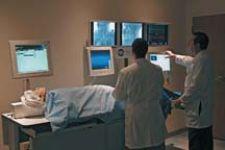

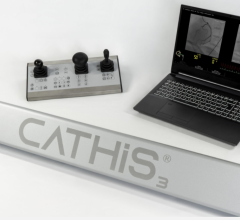
 March 11, 2022
March 11, 2022 

